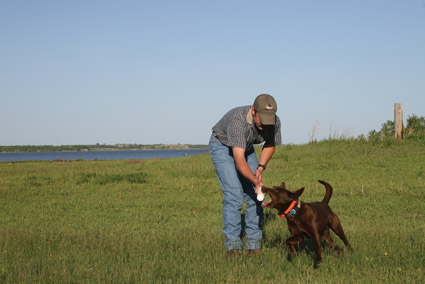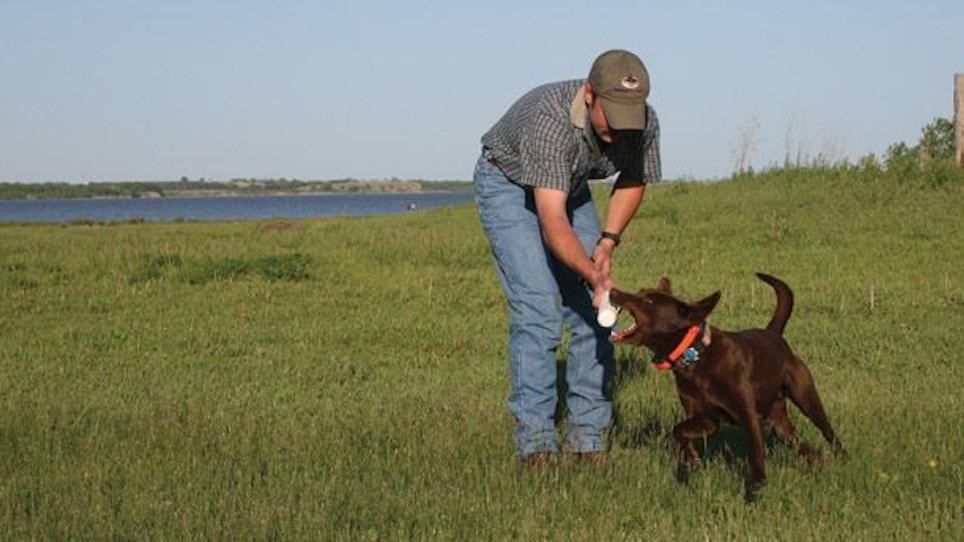<< See Part 1
 JP: So, without going into enough detail to make it its own feature — and it certainly can be that — just what are the proper sequential steps to force-fetching?
JP: So, without going into enough detail to make it its own feature — and it certainly can be that — just what are the proper sequential steps to force-fetching?
GH: In a nutshell, they go like this:
1. Start with the toe-hitch or ear-pinch exercise that gets the dog to open his mouth in response to pressure. I use the toe hitch because it lets me avoid hand contact with the dog and any association that might go with it. Plus there’s more control because the dog’s immobile on the bench. Each time I pull on the string and it tightens on the dog’s toe, he opens his mouth and I stick in a round dowel — never start force-fetching with a bird. The minute I get the dowel in his mouth I release the pressure. Repeat this enough and the dog associates the toe hitch as the cue to get his mouth on the dowel — he learns to turn the pressure off by getting the dowel. Once he’s reaching for the dowel on the hitch, you can pair that toe hitch cue with your fetch command. Repeat until the association is complete, i.e., you say “fetch” or “hold” and the dog reaches for the dowel reliably without the need for the toe hitch (and now you can use the toe hitch for reinforcement if the dog hesitates or gets distracted after you’ve given the command).
2. Once he’s reaching for the dowel on the toe-hitch cue, I introduce hold. I’ll aid the dog while I’m doing this, with a hand under the chin helping him to keep his mouth closed, but the gist of the exercise is the same as in step one. If he drops the dowel, I pull on the toe hitch, something he already associates with the cue to get the dowel. Again, I repeat until he’s holding, on the bench, on his own, and I apply the toe hitch, if he drops it.
3. Repeat these exercises with the dog running up and down the bench, scooping up the dowel from the bench and moving toward the dowel you hold in your hand from the other end of the bench. You still have control, still have the toe hitch to reemploy if the dog drops the dowel or becomes distracted.
4. Now it’s time to transition to the e-collar. Using the lowest level of stimulation the dog will respond to, I’ll begin to apply stimulation right after I use the toe hitch — not simultaneously with the toe hitch, but a beat after. Remember the dog doesn’t know what the collar stimulation means, only the toe hitch. What you’re doing is transitioning the dog from the toe hitch cue to the collar cue so you can work with the dog on the ground.
5. Move to the ground and repeat the processes above. Then extend your holding range. Have him hold the dowel while you go to the mailbox, while you walk around the house, when you take a walk in the park, anywhere and everywhere. Once he’s reliably holding and retrieving on the ground, responding to stimulation from the collar, it’s time to go back to the bench.
6. We go back to the bench at this time to change the hold object. It doesn’t matter what. It can be a hairbrush, a glove, a rolled-up towel, a retrieving dummy or anything else you can imagine that’s suitable to the task, but mix it up and repeat the fetch and hold drills completely for each object before moving onto the next. You should go through several objects — but still not a bird. In this manner the dog learns to hold anything you tell him to. It’s at this point that if you saw hardmouth or buttermouth early on in the training — he either tried to turn the dowel into toothpicks or barely hung on to it — that you will see these behaviors dissipate. The dog is now beginning to understand what you’re asking of him. His attitude will have changed at this point, going from either fighting you or sulking to the happy, enthusiastic dog you want him to be.
7. Back to the bench, now with a clipped-wing pigeon. Repeat the process as you did for the dowel and other hold objects and using the toe hitch first, then the collar. If he mouths the bird, apply low-level stimulation to the e-collar until he stops mucking around with it — that’s not a distraction for the dog, it’s a correction. I’ll be aiding him initially, too, just as I first did with the dowel, by helping hold the dog’s mouth shut. I’ll then go through the running bench process, and then move to the ground as I did before.
8. Once I’ve got the dog solid on the ground with pigeons, I’ll go back to the bench and repeat the entire process with each bird the dog’s going to hunt later on.
JP: Wait a minute. You repeat the entire force-fetching procedure with each bird you expect a dog to hunt? Ducks, geese, pheasants, quail?
GH: Sure. Have to.
JP: I did my force-fetching with a NAHRA field trial trainer, and once we got to pigeons, that was it. Noah never had any other birds “introduced” to him.
GH: Right. And you’ve hunted pheasants with him, correct?
JP: Yes.
GH: And it’s probably fair to say he’s been spurred more than a few times by cripples, right?
JP: Yes.
GH: You’ve also hunted geese with him?
JP: Yup.
GH: So it’s probably fair to say he’s been beaten up by one here and there. Imagine you’re him. One way to turn off spurring pheasants and large, hard-flapping waterfowl is to bite down hard and kill, wouldn’t you say?
JP: Makes perfect sense. But Noah’s 10 years old now. It’s probably too late to do anything about it.
GH: Not at all. Simply go back to the force-fetching process from the start. It’ll go fast since he already knows what the cues and commands are, but if you go through the steps as I’ve outlined them, his hardmouth will disappear.






